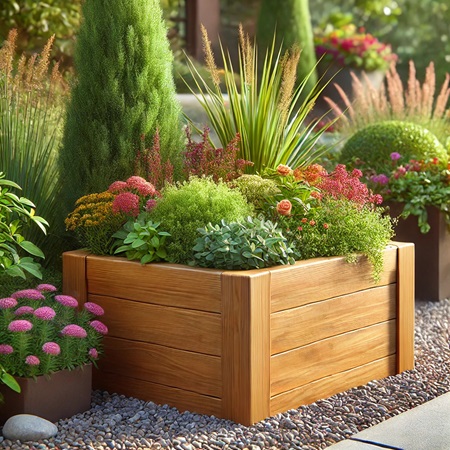Cedar planters are a popular choice for gardeners due to their aesthetic appeal, natural resilience, and versatility. However, like any gardening tool, cedar planters come with their own set of advantages and disadvantages. Understanding these can help you decide if cedar is the right material for your gardening needs.
Advantages of Cedar Planters
Natural Resistance to Decay and Insects
Cedar wood contains natural oils and chemicals that make it highly resistant to decay, rot, and insect infestations. This makes cedar planters last longer than many other types of wood planters, which tend to decay more quickly when exposed to soil and moisture.

Aesthetic Appeal
Cedar planters have a beautiful, rustic appearance, often featuring warm, reddish tones with a pleasant, earthy aroma. Over time, they weather to a silvery gray, adding a unique character to garden spaces. This aesthetic quality is ideal for both traditional and modern outdoor decor.
Environmentally Friendly
Cedar is a sustainable and biodegradable material, especially if harvested responsibly. It’s often sourced from renewable forests, making it an eco-friendlier choice compared to synthetic materials like plastic. When a cedar planter reaches the end of its life, it can be composted or disposed of in an environmentally friendly way.
Temperature Regulation
Cedar has natural insulating properties, which can help protect plant roots from extreme temperatures. During hot summers, cedar planters can help maintain cooler soil, while in colder climates, they help retain some warmth, allowing for healthier root development.
Lightweight and Easy to Move
Compared to planters made of concrete or ceramic, cedar planters are relatively lightweight, making them easier to transport and rearrange. This can be especially advantageous for gardeners who may want to move plants indoors during colder months or adjust plant positioning based on sunlight.
Long Lifespan
Cedar planters generally last longer than other types of wood planters, often providing years of use without significant degradation. This makes them a cost-effective investment for gardeners who prioritize longevity and durability in their gardening supplies.
Disadvantages of Cedar Planters
Higher Initial Cost
Cedar planters tend to be more expensive than planters made from other materials like plastic, pine, or composite. While they may be more cost-effective over time, the higher upfront cost can be a drawback for budget-conscious gardeners.
Requires Periodic Maintenance
Although cedar is naturally resistant to decay, it can still benefit from occasional maintenance. Applying a natural, food-safe oil treatment annually can help preserve the color and lifespan of the wood, especially if the planter is exposed to direct sunlight and harsh weather conditions. This maintenance may be necessary to retain the desired look and performance of the planter.
Limited Sizes and Styles
Cedar planters are typically available in standard shapes like rectangular boxes or square beds. For those looking for highly customizable or intricate designs, cedar may not offer as much variety as materials like plastic or metal, which can be molded into numerous shapes and sizes.
Prone to Color Change
Over time, cedar naturally changes color when exposed to the elements. While some gardeners appreciate the weathered gray color that cedar develops, others may find it less appealing. Regular oiling can help preserve the original color, but this requires additional effort and resources.
May Be Too Lightweight for Windy Areas
While the lightweight nature of cedar planters is beneficial for mobility, it can be a disadvantage in particularly windy environments. In such cases, these planters may need extra support or anchoring to keep them stable, especially when filled with tall plants that can act as wind catchers.
When Cedar Planters Are the Best Choice
Cedar planters work particularly well for:
- Long-term gardening projects: Cedar’s longevity makes it ideal for those planning to use their planter for multiple growing seasons
- Aesthetic-focused gardeners: If the look of natural wood complements your garden or home aesthetic, cedar is an excellent choice.
- Eco-conscious gardeners: Since cedar is a renewable, biodegradable material, it’s perfect for those looking to make sustainable choices.
When to Consider Other Planter Options
In some cases, alternative materials might be more suitable:
- Budget limitations: Gardeners on a strict budget may prefer more affordable materials like plastic.
- Non-rustic aesthetic: If you’re seeking a more contemporary look, metal or ceramic planters may better fit your design vision.
- Low-maintenance requirements: If you prefer minimal upkeep, materials like plastic or fiberglass may suit you better since they don’t require oiling or sealing.
Conclusion
Cedar planters are a fantastic choice for gardeners seeking durability, natural beauty, and sustainability. While they come with a higher initial cost and require some maintenance, they offer advantages like insect resistance, weather resilience, and long-lasting appeal. However, for those looking for low-cost, maintenance-free options or more diverse styles, other planter materials may be more suitable. In the end, the choice depends on your personal priorities, gardening goals, and aesthetic preferences.



Comment here